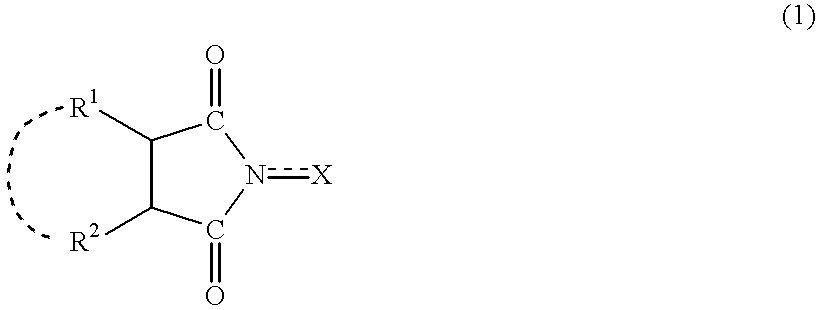Process for cooxidizing organic compounds, process for producing epoxy compounds and process for producing esters or lactones
a technology of cooxidizing organic compounds and epoxy compounds, which is applied in the direction of organic compounds/hydrides/coordination complex catalysts, organic chemistry, physical/chemical process catalysts, etc., can solve the problems of process using microorganisms, process instability, and process using unstable olefins. achieve the effect of simple operation and efficiency
- Summary
- Abstract
- Description
- Claims
- Application Information
AI Technical Summary
Benefits of technology
Problems solved by technology
Method used
Image
Examples
example 2
A mixture of 2 mmol of 2-octene (a mixture of cis-isomer and trans-isomer), 20 mmol of 1-phenylethanol (.alpha.-phenethyl alcohol), 0.6 mmol of N-hydroxyphthalimide, 0.6 mmol of hexafluoroacetone trihydrate, and 2 ml of trifluoromethylbenzene was stirred at 90.degree. C. under an oxygen atmosphere (1 atm) for 22 hours. Gas chromatographic analysis of products in a reaction mixture revealed that 2-octene was converted, at a rate of 91%, into 2,3-epoxyoctane in yield of 70%.
example 3
A mixture of 2 mmol of 2-octene (a mixture of cis-isomer and trans-isomer), 10 mmol of 1-phenylethanol (.alpha.-phenethyl alcohol), 0.2 mmol of N-hydroxyphthalimide, 0.4 mmol of hexafluoroacetone trihydrate, 0.001 mmol of cobalt (II) acetate, and 2 ml of trifluoromethylbenzene was stirred at 70.degree. C. under an oxygen atmosphere (1 atm) for 16 hours. Gas chromatographic analysis of products in a reaction mixture revealed that 2-octene was converted, at a rate of 77%, into 2,3-epoxyoctane in yield of 56%.
example 4
A mixture of 4 mmol of 2-octene (a mixture of cis-isomer and trans-isomer), 20 mmol of tetralin, 0.4 mmol of N-hydroxyphthalimide, 0.2 mmol of molybdenum hexacarbonyl, 0.004 mmol of cobalt (II) acetate, 200 mg of Molecular Sieve 4A, and 2 ml of benzonitrile was stirred at 50.degree. C. under an oxygen atmosphere (1 atm) for 20 hours. Gas chromatographic analysis of products in a reaction mixture revealed that 2-octene was converted, at a rate of 82%, into 2,3-epoxyoctane in yield of 72%, and that tetralin was converted, at a rate of 42%, into .alpha.-tetralol (yield: 21%) and .alpha.-tetralone (yield: 43%).
PUM
 Login to View More
Login to View More Abstract
Description
Claims
Application Information
 Login to View More
Login to View More - R&D
- Intellectual Property
- Life Sciences
- Materials
- Tech Scout
- Unparalleled Data Quality
- Higher Quality Content
- 60% Fewer Hallucinations
Browse by: Latest US Patents, China's latest patents, Technical Efficacy Thesaurus, Application Domain, Technology Topic, Popular Technical Reports.
© 2025 PatSnap. All rights reserved.Legal|Privacy policy|Modern Slavery Act Transparency Statement|Sitemap|About US| Contact US: help@patsnap.com



